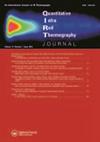感应和传导热成像缺陷检测机制:电流流动和缺陷特定升温
IF 4.9
3区 工程技术
Q1 INSTRUMENTS & INSTRUMENTATION
引用次数: 8
摘要
电磁激励有源热像仪是一种可靠的无损评价方法,具有广泛的应用前景。它允许检测不均匀性,如裂缝,或接近导电元件的表面快速可靠地利用红外成像。电流可以以两种方式用于热成像:在感应热成像中,电流通过将交流电流通过靠近被测元件的线圈耦合到元件上,而在传导热成像中,电流直接耦合到元件上。在过去的几年中,人们研究了电磁激励的基本原理,包括待测部件材料的影响和必要的后处理算法。本文介绍了各种缺陷模型的参数研究及其检测机制。从组件内部和涂层与组件之间的分层型缺陷开始。继续与裂缝型缺陷打开到表面,如众所周知的槽型和缺口型裂纹,接触点和“导电率降低区域”型裂纹。对于这些类型的参数,如深度,宽度,长度,电感位置,旋转,倾斜和电导率进行了讨论。本文总结了表面下裂纹和隐藏在非导电涂层下的裂纹。本文章由计算机程序翻译,如有差异,请以英文原文为准。
Defect detection mechanisms with induction and conduction thermography: current flow and defect-specific warming
ABSTRACT Active thermography with electromagnetic excitation, is a reliable non-destructive evaluation method with a wide range of applications. It allows detecting inhomogeneities, like cracks, at or close to the surface of conductive components fast and reliable utilizing infrared imaging. Electric current can be used in two ways for thermography: In induction thermography a current is coupled to the component by passing an AC current through a coil which is close to the inspected component, while in conduction thermography the current is coupled directly into the component. Over the past years the basics of electromagnetic excitation, including the influence of the material of the component to be tested and the necessary post-processing algorithms have been studied. In this paper parameter studies on a comprehensive variety of defect models and their detection mechanisms are presented. Starting with delamination type defects, both within a component and between a coating and the component. Continuing with crack type defects open to the surface, like the well-known slot and notch type cracks, contact-point and ‘area of reduced conductivity’ type cracks. For those types’ parameters like depth, width, length, inductor position, rotation, inclination, and conductivity are discussed. The paper concludes with sub-surface cracks and cracks hidden under non-conductive coatings.
求助全文
通过发布文献求助,成功后即可免费获取论文全文。
去求助
来源期刊

Quantitative Infrared Thermography Journal
Physics and Astronomy-Instrumentation
CiteScore
6.80
自引率
12.00%
发文量
17
审稿时长
>12 weeks
期刊介绍:
The Quantitative InfraRed Thermography Journal (QIRT) provides a forum for industry and academia to discuss the latest developments of instrumentation, theoretical and experimental practices, data reduction, and image processing related to infrared thermography.
 求助内容:
求助内容: 应助结果提醒方式:
应助结果提醒方式:


